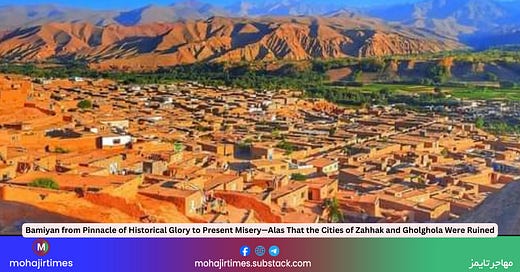Bamiyan from Pinnacle of Historical Glory to Present Misery—Alas That the Cities of Zahhak and Gholghola Were Ruined
The people of Bamiyan struggle with soaring food prices and essential goods and have adapted to this dire economic situation
By Aman Shadkam
Every pleasure in this world is accompanied by toil and hardship; if it does not burden us at the moment, it will inevitably become a source of trouble in the future. There are only two joys that never bring about regret or misfortune: doing good to others and fulfilling one’s duty. – Jean-Jacques Rousseau
Humans are reflective and contemplative beings, imbued with dignity, purpose, planning, pain, sorrow, joy, and happiness. They are committed and honest, yet tragically, they can also be savage, fierce, and monstrous. There is not enough space here to delve into all these concepts, but I will briefly touch upon the pain, suffering, poverty, and political turmoil of the people of Bamiyan, who have endured years of oppression and discrimination by despotic and prejudiced regimes.
Bamiyan, a land of historical significance, was once a peaceful and serene city inhabited by relatively enlightened people, steeped in pain and sorrow, poverty and destitution, yet full of refinement and purity. At one time, this city was unparalleled in beauty and culture across Asia. Its cities radiated knowledge and wisdom. Towering trees adorned and beautified the city. It had its own light, symbolized by its unique ideology and power, independent of anyone else. It was the core of an empire, a magnificent palace for its kings. Bamiyan had light, and its light had brilliance. Indeed, Bamiyan was considered a great civilization in Asia.
Bamiyan had the city of Zahhak, and Zahhak had enlightened and awakened people, like Kaveh the Blacksmith, who raised the cry for justice and stifled the voice of tyranny in the throat of the dictator of the time. He brought his people the gift of freedom and a life free from humiliation and disgrace. Unfortunately, the people of Bamiyan did not properly honor the vigilance and courage of Kaveh the Blacksmith and allowed oppressors to climb upon their chests.
A few kilometers from Zahhak lies the city of Gholghola, rich in both spiritual and material treasures. In its heyday, Bamiyan competed with the historical cities of India and present-day France. It had no rivals in beauty, and its people were hospitable and civilized. Bamiyan was a major stop along the Silk Road, a resting place for traders, tourists, and travelers from national and international. This road was a foundation for the economic and cultural growth of the people of Bamiyan. The city of Gholghola was a cradle of civilization. Every morning, the skyscrapers gazed upon Gholghola and Buddha, painting portraits of its citizens and girls. The girls of Bamiyan played, laughed, and joyfully roamed about, sharing their pains like a single soul in multiple bodies. There were no oppressive forces along their paths. They had no culture of stoning, no foolish superstitions, and everyone had the right to live.
The city of Bamiyan and its inhabitants had a god, a god visible to their eyes. Every day, they blessed themselves and confided in their deity. Their god spread golden light every morning, bathing the city in gold. The citizens would march and gaze at the golden light from the cliffs of this land. The Buddha statues bestowed beauty upon Bamiyan and strength upon its people. Every morning and evening, Shahmama adorned herself for Salsal, her musk scent perfuming the civilized city of Bamiyan, infusing its people's hearts with love and affection. But where has all this beauty and civilization gone? Alas, the towns of Zahhak and Gholghola have been destroyed. Only their fossils remain.
Where have the Buddha statues gone? In a word, they were destroyed and ruined due to the power lust and exclusivity of fascists and fundamentalists. We no longer have a civilized city. We no longer have light. We no longer have civilization, and we no longer have freedom. The girls in this beautiful city no longer play or study; they carry the burden of fundamentalism and asceticism. Now, we are of the breed of fundamentalists, bearing zeal, shame, and modesty! Our awareness and capabilities are reduced to pointless displays of zeal and misplaced shame. The current life of Bamiyan’s citizens is marked by poverty, destitution, unemployment, oppression, and tyranny, with personal connections prevailing over merit.
Bamyan During the Republics of Hamid Karzai and Ashraf Ghani Ahmadzai
During the republics of Mr. Karzai and Ghani, Bamyan province, despite facing security and economic threats, was renowned for its cultural and social vibrancy both nationally and internationally. The citizens were ardently pursuing education and knowledge, seeking humanity and progress in the enlightened faces of learning. They participated spontaneously in the republic's symbolic elections. However, the U.S.-backed rulers (Puppet) rarely paid attention to issues like security, economy, and education in Bamyan. The province's relative peace was attributed to the awareness, pacifism, and human-centric mindset of the Hazara people, unlike the troubled districts of Marjah and Panjwayi in the Kandahar and Helmand provinces. Otherwise, nothing like the Marjah and Panjawai districts of Kandahar and Helmand provinces, as well as other known provinces, wouldn't be in place. The people of Bamiyan used to tie stones to their stomachs because of hunger, and their houses were damp caves of Bamiyan, and their honorable food was Bamiyan potatoes.
Administrative and moral corruption was rampant in Bamyan province as in Daikundy Province, and the local government system in Bamyan was based on partyism, corruption, and nepotism. Most government posts and offices in Bamyan were reserved for a certain tribe and region, and the children of uncles, aunts, and friends took over the government offices. Moral corruption was increasing day by day—rape and murder were on the rise. However, there were corrupt people in the layers of administrations of Bamyan province. They tried to suffocate the voice of freedom and humaneness of Bamiyan, but in the end, they still suffocated it.
Worse still, those in the military sector acted with impunity, committing various crimes and corrupt acts. The book “Afghanistan's Romeo and Juliet” recently published in Farsi/Persian, recounts the story of Zakia’s romantic escape from Sorkhdar in Foladi Valley, Bamyan, in 2012. It also tells of another girl named Safora, who sought refuge in Bamyan's safe house to escape murder by her family. During her court meeting, court employees gang-raped her in a backroom. In 2017, when I was a fourth-year student at Bamyan University, two police officers abducted a young girl in a folder model vehicle, took her to a remote valley, intoxicated her with alcohol and drugs, raped her, and abandoned her there.
The Bamyan Status Under Current Ruling (Taliban)
Today, the citizens of Bamyan live with a flicker of hope and aspiration for liberation from their current predicament and the arrival of sane and compassionate rulers. They dream of electing a committed, honest leader to end their poverty and darkness. The people of Bamiyan struggle with soaring food prices and essential goods and have adapted to this dire economic situation. There are no job opportunities for workers, and the Taliban regime imposes heavy, unjust taxes, stealing the people’s livelihood. Administrative corruption is rampant in Bamyan, and the Taliban governance of Bamyan is based on connections over merit. Most government offices are dominated by a specific ethnic group, institutionalizing this unfavorable trend. Girls are barred from schools and universities—male students at Bamyan University study in desperate conditions without experienced and dedicated professors. The university has become more minor and less standard than even an underdeveloped school in Kabul, with inadequate facilities and unqualified teachers.
Worse than this, the Taliban Islamic Emirate has made the students more worried and isolated by creating a series of cultural restrictions. Students are now like slaves. Of course, they are right because if there is a criticism of the poor quality of the university in Bamyan, they will be treated inhumanely like criminals. Also, they have hired maulvis to positions at the university to teach the professors of Bamyan University about the Prophet's life. Such actions are considered an insult to a scientific center and the wisdom of professors.
Bamyan University lacks a proper library and study hall, as it did during the republic. Students used to study under trees during the day and in well-lit streets at night, and this remains unchanged. The city is dark due to power outages, and the rare electricity available is prohibitively expensive. Despite these challenges, students during the republic were resilient, fighting social, economic, political, and cultural adversities advocating for justice and humanity.
Along with their research and studies, they beat the fist of history in the mouths of militants and stubborn people; they whispered the slogans of justice and humanity. However, the current students of Bamyan University have been oppressed by an academic generation, and they cannot shout for justice and freedom. Of course, I emphasize again that the current students of Bamyan University should be given the right because if they stand up against the university's monogamy and lack of quality, they may be dragged to prison cells by the ruling system and eventually be given shameful nicknames such as “Rebellious and Infidel.” in society, will be awarded to students.
Young girls are publicly flogged for accusations of adultery and escaping house, yet no one dares to raise a voice against this injustice due to the pervasive atmosphere of fear. Conversations with Bamyan’s citizens reveal their tendency to deny the harsh realities, focusing only on survival. Also, the Taliban Islamic Emirate has zoomed on and targeted Bamyan province more than other regions.
For example, the Taliban have adapted the color of their desired taxis only in Bamyan province. Of course, if we consider such issues from the point of view of theory, the goals of the current rulers are more applicable in the areas under their rule, where they have controllable control over the people of those areas. The Taliban exploits Bamyan’s impoverished and helpless people to falsely showcase support for their regime globally, thus attempting to whitewash their image for the world forcibly on the people.





